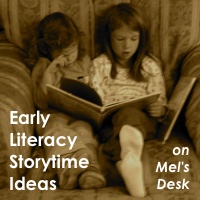Although children’s gross motor and fine motor skills are both developing all the time, many fine motor skills take more patience and cognitive development than gross motor skills. Think of a baby who can mush applesauce around on her tray (arms) before she can pick up a Cheerio (fingers). In addition, small muscles get tired more quickly than big ones (could you hang from the monkey bars longer from your hands or your knees?). Using arm and body motion activities to is a way to introduce children to letter-shape or directional concepts while they are still working on learning how to hold and use crayons and pencils with confidence.
Using scarves is one way to introduce purposeful movements into storytime. We often use scarves and open-ended activities with music, but we can use them in more directed ways too. We want to be careful to do so in age-appropriate ways, though. Here are a few ideas:
Babies:
Encourage the walkers to move their scarves up high and down low and around in a circle. Can they “swim” their scarf like a fish through the air? Can they drag their scarf like a snake on the floor? Encourage parents of babies to see if their children will grasp the scarf. Parents can help their babies move their baby’s arms and watch the scarf move, or pull gently on the other end of the scarf in a little game of tug of war. They could also tie it gently around an ankle and prop the baby so they can see what happens when they kick their feet.
Toddlers:
Have the children move their scarves in different ways. Some ideas are: from high to low, from low to high, in a rainbow (arc over their heads), upside down rainbow or a smile (a big “u” shape in front of their bodies), a big circle (whole arm), a little circle (just moving forearm or wrist), bumps (little humps from left to right), zigzag (like a Z, from top to bottom, or like a W from left to right). These are all line shapes that make up letters, but without requiring letter knowledge yet from our little ones.
Preschool/Family:
You can encourage preschool children to hold the scarf between their pointer finger and their thumb—this is a “pincher grip” and good for fine motor development. Make letter shapes in the air together. You could write a letter first on a whiteboard to give the kids something to copy. Say aloud the movements as you go. “Let’s make an M! Start down on this side of your body, now go straight up! Move down to the middle by your tummy! Now go up to the other side! Now move down to this side of your body.” OR, “Let’s make an O! An O is like a circle, it goes around and around! Start at the top! Go around to the top again!”
When you’re done, collect the scarves and say something like this to the adults: “Grownups, when you and your kids play with scarves or ribbons or magic wands, your children are developing their arm muscles and starting to learn about lines and shapes. These muscles and concepts will help them when they are learning to write. Playing with your children will help them get ready to read and write.”



.jpg)

6 Responses to Early Literacy Storytime: Scarves and Letters